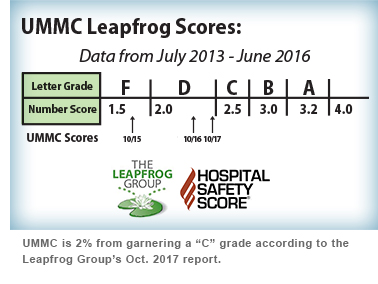Leapfrog and Our Journey to High Reliability
Good morning!
This week we received our latest scores from the Leapfrog Group. As many of you know, Leapfrog publishes “hospital safety ratings” twice each year based on data available to the public from the Centers for Medicare and Medicaid Services and a self-reported hospital survey, which is optional.
 You may also remember – and I certainly will never forget – that in October 2015 UMMC received a letter grade of “F” in the Leapfrog survey, which was widely reported in the media. That was a clear signal we needed to make a turnaround in our clinical quality program.
You may also remember – and I certainly will never forget – that in October 2015 UMMC received a letter grade of “F” in the Leapfrog survey, which was widely reported in the media. That was a clear signal we needed to make a turnaround in our clinical quality program.
What few outside UMMC understood was that we already had begun the turnaround seven months earlier with the recruitment of Dr. Michael Henderson as chief medical officer and leader of our quality improvement efforts. In the years preceding his arrival, we had been working on quality issues in a focused manner, but it sometimes seemed like we were spinning our wheels. Dr. Henderson brought us the vision of where we needed to go and a roadmap of how to get there.
The first order of business was to adopt quality improvement as our No. 1 strategic priority. That meant we would invest whatever resources were necessary to affect positive, sustained change. At Dr. Henderson’s direction, we also adopted a three-pronged strategy consistent with high-reliability organizations, with a focus on leadership engagement, a culture of safety and a systematic approach to performance improvement.
Dr. Henderson assembled a high-performing, committed team to help carry out this strategy. This involved restructuring some of the ways we had traditionally operated in the clinical setting – not always an easy lift, but we did it.
Finally, the real work began. Performance gaps were defined and focused goals with specific targets for improvement were set to close those gaps. Structured teams, with clinical leaders paired with process engineers, developed projects to engage frontline employees in the improvement work.
A key to this work has been the capture of simple, timely and actionable data to establish baseline performance and show progress on projects with monthly updates on our hospital scorecard. Communication about the projects and data transparency are additional key factors in driving change, combined with regular reviews with senior leadership for accountability.
Since those initiatives began taking hold, we’ve made steady progress. For example, from January 2016 to the present:
- Hospital-acquired infections have been reduced by 35 percent
- Patient Safety Indicators (complications) have fallen 85 percent
- 30-day readmissions are down 10 percent
- 30-day mortality observed-to-expected ratio is down 12 percent
- Patient experience has improved by 50 percent
Unfortunately, the Leapfrog scores that came out Tuesday still rely in part on CMS data that is 2-3 years old. UMMC’s Jackson campus received a “D.” Even so, the numeric scale that underlies the letter grades shows that we are within 2 percent of a “C” and that our overall score is 33 percent higher than two years ago.
On the other hand, UMMC Grenada, which scored a “C” in the last survey six months ago, received an “F” this time. We have questions about how this happened – or if it’s even possible – to change two letter grades in such a short time. Dr. Henderson has reviewed the data and it is essentially unchanged from the previous survey. So we will be exploring this further to determine what happened.
Overall, we are making progress. We are on the right path to becoming an “A” hospital within a few years. But our work is far from done. In fact, the mark of a high-reliability organization is that the work of continuous improvement is never done. Our patients deserve nothing less.
So I’m not ready to celebrate, but I do commend Dr. Henderson and his team, our health system leaders, clinical department chairs and nursing leaders for the progress we’ve made during the last two-and-a-half years. They would be the first to say we can only achieve our goals if this quality movement is embraced by every person here whose work touches a patient. And that’s just about everybody. So thank you for what you’ve done so far, and what you will do in the future, to help us all achieve A Healthier Mississippi.



